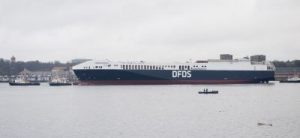Feature, Freight News, Sea
DFDS takes delivery of Gardenia as freight flourishes – updated
[ February 20, 2017 // Chris ]DFDS has taken delivery of the first of two new ro ro freight vessels from the Flensburger Schiffbau shipyard.
She and her sister ship, due to be handed over in September, are 210 metres long with capacity for 262 trailers with a load space of 4,076 metres and are set to enter service on DFDS’s Rotterdam-Immingham route. They will increase capacity by 20% compared with the tonnage they replace.
DFDS adds that its new construction programme includes two more ro ro freight vessels in 2019 and that more newbuildings in the freight and cruise sector are under consideration.
Executive vice-president of DFDS’s shipping division, Peder Gellert, commented: “The volume on all routes within the DFDS network has grown noticeably, we are already using almost all the capacity available in our existing fleet. Gardenia Seaways and the next new ship will enable us to offer our customers the capacity they want, together with a significantly improved service. The design of the ship, developed in Flensburg, meets current environmental requirements, reducing fuel consumption and providing much better handling when loading and unloading in port,” says Peder Gellert.
He added: “Gardenia Seaways is the first step for DFDS in an ambitious programme of newbuildings. The two ships from the Flensburger Schiffbau-Gesellschaft will be joined in 2019 by another two RoRo freight vessels. These will be the largest freight vessels in the DFDS fleet so far. DFDS is also considering the future construction of new combined freight and passenger ships, and the replacement of passenger ships.”
DFDS added that its annual report for 2016 showed that UK-Continental trade flows are holding up well despite the UK rBrexit vote last June. Full-year revenues for the group were up b
Improved earnings on DFDS’ cross-Channel routes from Dover to Calais and Dunkirk accounted for almost half a 52% earnings increase and the growth in both freight and passenger markets was reflected in strong market share gains in the latter part of the year.
Rising freight volumes in the final quarter of 2016 indicate that there was no impact on cross-border trade between the UK and Europe following the and indeed the business carried 17% more freight during this period than at the same time in 2015.
Depreciation of the Pound in the last six months of the year impacted on the full-year result, as offset by the continued increase in volumes and rates in the freight market. This growth was made possible by increases in capacity, thanks to the introduction of two new ships – the Cote de Dunes and the Cote de Flandres – on the Dover to Calais service, and on the key freight corridor on the North Sea.
Looking ahead to 2017, DFDS expects revenues to increase by a further 4% across its shipping and logistics business. With the Bank of England adjusting its growth expectations for the UK economy upwards to 2%, freight volumes, are expected to continue to increase.
Tags: DFDS












